Learn how acoustics can take kitchen and bathroom renovations to a new level. Get the latest noise-reduction techniques, soundproofing material and remodel contractor tricks to design quiet, high-performing areas.
When it comes to kitchen and bathroom remodels, then beauty and functionality tend to be center stage. However, there is one more element that influences comfort and satisfaction greatly, it is sound. Poor acoustics can be a downer to even the most luxurious remodel, whether it is clanging pots or that echoey tile. This is why remodel contractors, as well as homeowners, are slowly adopting acoustic design as an all-round remodeling approach. In what way does sound affect our lives and how can we create wonders that sound and feel great?
Understanding Acoustic Design in Residential Remodeling
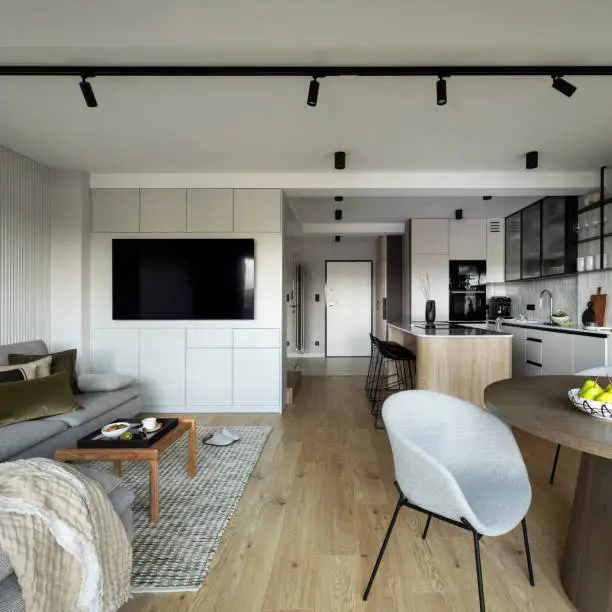
Acoustic design creates the senses of a home. Although it is commonly used in theaters or in music rooms, it is also significant in highly trafficked rooms such as kitchens and bathrooms.
The Role of Sound in Perceived Comfort and Wellness
Sound has a rather unexpected contribution to emotional well-being. Tension can be caused by harsh echoes, buzzing vents or loud appliances, even though you may not be aware of them. A room that has an even acoustics is more relaxing, more intimate and more conducive to everyday activities. The atmosphere is as influenced by the lack of sound as it is by the surfaces, when you are cooking dinner or relaxing in the bath.
Common Noise Issues in Kitchens and Bathrooms
Kitchens and bathrooms amplify sound due to hard surfaces like tile, stone, and glass. Common problems include:
- Echo from high ceilings or open layouts
- Appliance noise, such as dishwashers and bathroom fans
- Running water sounds from plumbing and drains
- Cabinet doors slamming or drawers sticking
These small disturbances can build up and create sensory fatigue — especially in shared or small-space living environments.
Acoustic Solutions for Kitchen Remodeling
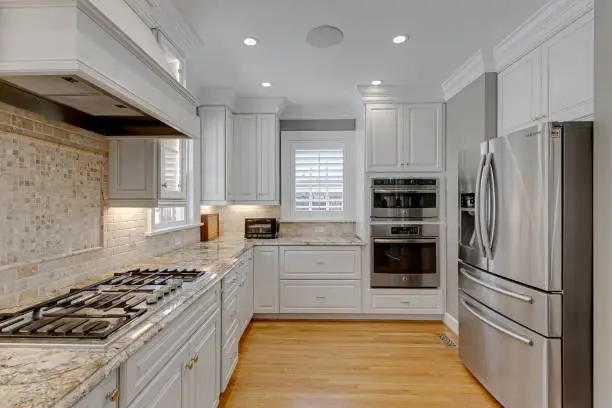
The contemporary kitchen is hectic, open, and in most cases, it is next to other living spaces. Considerable acoustic decisions also serve to reduce interference and facilitate comfort.
Sound-Absorbing Materials and Layout Planning
Textured finishes are soft, and they can significantly minimize reverberation. Consider fabric window coverings, cushioned carpets or acoustical wall panels concealed behind decorative features. Even upholstered seating of high backs in a breakfast nook can serve to absorb sound.
Kitchen Acoustic Enhancers:
- Area rugs with padded underlayment’s
- Acoustic plaster or sound-absorbing ceiling panels
- Cabinets lined with felt or cork for utensil noise dampening
Additionally, layout matters. Placing noisy zones (like the dishwasher) away from gathering areas creates natural sound breaks that enhance flow and function.
Quiet Appliances and Cabinetry Features That Minimize Noise
Decibel ratings are now applied with modern appliances, and most of them are designed to work quietly. Find labeled dishwashers, range hoods, and refrigerators with the label of quiet or below 45 dBA.
Cabinet innovations also reduce noise:
- Soft-close hinges prevent doors from slamming
- Full-extension glides eliminate loud jerks when opening drawers
- Insulated trash pull-outs can further contain odor and sound
Working with experienced remodel contractors ensures these acoustic features are integrated from day one.
Reducing Echo and Water Noise in Bathroom Designs
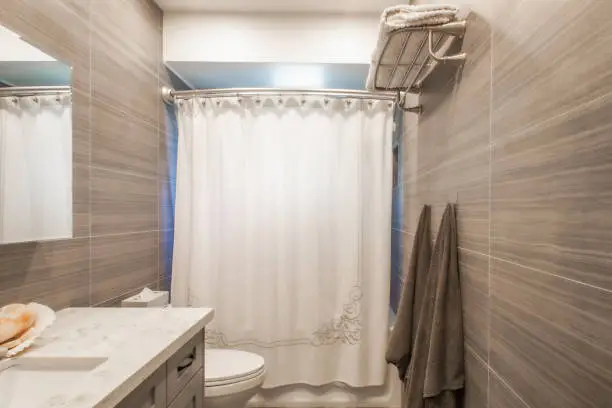
Bathrooms are notorious with echoes and splash sounds, yet some thoughtful decisions can make them places of silence.
Materials That Dampen Sound in Tiled Spaces
Tile is a staple in bathrooms, but it bounces sound. The solution? Balance it with elements that absorb:
- Textured wallpapers or acoustic wall panels
- Vinyl-backed bathmats that reduce impact noise
- Fabric shower curtains that soften acoustics versus glass enclosures
High-quality caulking and grout also play a subtle acoustic role by reducing vibration transfer between surfaces.
Ventilation, Fan Noise, and Acoustic Ceiling Panels
Ventilation is a must, but fans need not to be as loud as turbines. Select units that are marked as quiet or less than 1.0 sone to have a quieter setting. There are even those which have motion sensors and night light to make them more comfortable.
Ceilings are usually ignored, though acoustical panels or special tiles may absorb the sound that bounces off high ceilings or tile-covered bath areas.
Bathroom Sound Control Tips:
| Solution | Acoustic Benefit |
|---|---|
| Quiet ventilation fans | Reduces ongoing hums and vibrations |
| Cork or vinyl wall panels | Breaks echo from tile-heavy surfaces |
| Layered textiles (towels, rugs) | Naturally dampens reverb and splash sounds |
Designing for Peace: Working with Remodel Contractors on Acoustics
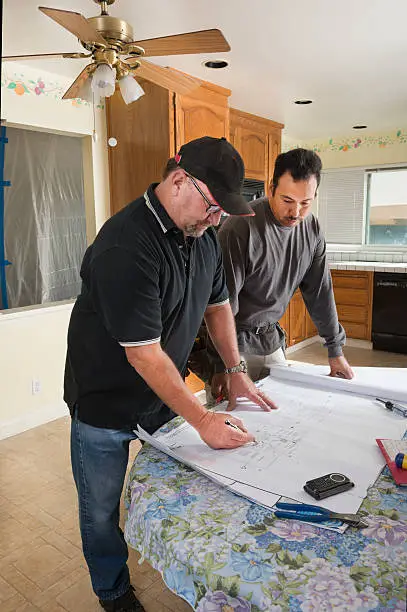
Working with professionals will guarantee that your acoustic vision is fulfilled as well as aesthetic and structural plans.
Questions to Ask Your Kitchen and Bathroom Remodeling Company
Sound control often requires early-stage planning. Here are key things to ask your remodel contractors:
- Do you use materials that support noise reduction?
- Can you recommend quiet appliance models or brands?
- Is it possible to add soundproofing to walls without compromising layout?
- How will ventilation and lighting systems affect sound?
A contractor well-versed in acoustics for kitchen and bathroom remodels will offer integrated solutions that fit your lifestyle and budget.
Coordinating Sound Control with Lighting and Layout Plans
Acoustic improvements don’t have to exist in a vacuum. In fact, the best results come from linking them to:
- Lighting zones, to create peaceful ambiance alongside quietude
- Flooring transitions, which can soften footsteps and seal gaps
- Wall insulation, to block noise between adjacent rooms
This synergy elevates the final result — creating environments that both look and sound thoughtfully composed.
Small Space Soundproofing Tips for Bathrooms and Kitchens
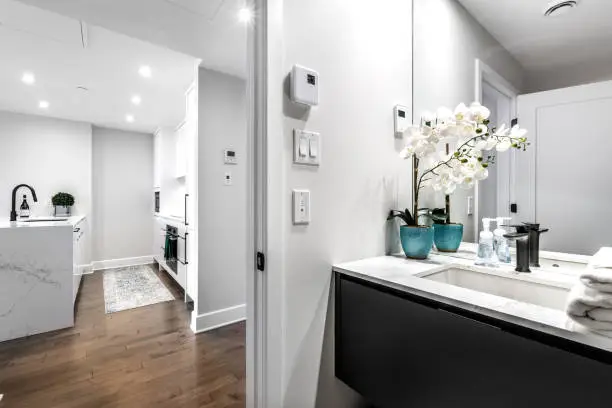
The smaller houses, condominiums, or apartments usually experience a problem with sound. These are the ways to safeguard your tranquility in small areas.
Ideal Acoustic Solutions for Condos and Townhomes
Multi-unit dwellings often contend with shared walls and limited buffer zones. Prioritize:
- Mass loaded vinyl (MLV) under cabinets or flooring
- Wall insulation upgrades behind vanities or refrigerator panels
- Door sweeps and weatherstripping, especially in powder rooms
These fixes block both airborne and impact noise without major design overhauls.
Budget-Friendly Sound Control Options
Acoustic improvements don’t have to break the bank. Try:
- Hanging large artwork or tapestries that double as wall dampeners
- Using cork-backed flooring to muffle steps
- Swapping out old fans or range hoods for low-decibel models
Bulletproof on a Budget:
- Acoustic caulking under baseboards
- Felt pads on drawers and cabinet doors
- Weighted shower curtains
Each of these choices builds toward a space that feels more private and peaceful, without requiring a full renovation.
Frequently Asked Questions (FAQs)
1. Why are acoustic design important in-home remodels?
Acoustic comfort is the way we perceive space. A well-remodeled kitchen or bathroom can be harsh or oppressive due to its echo or undesirable sound even though the design is beautiful. Acoustical design can assist in limiting noise, clarity of speech, and relaxation, particularly in homes with open designs or common living quarters. Making sound quality a priority can increase functionality and emotional health.
2. Can I reduce appliance and plumbing noise in my remodel?
Yes, and it is becoming more and more common. It is possible to reduce operational noise by installing quiet appliances with low decibel ratings and insulation of plumbing lines. There are also remodel contractors you can consult to choose quiet-range hood, under-cabinet insulation and padding under sinks and dishwashers. These enhancements can be particularly useful in the open-concept house where the sound travels freely.
3. What are the best materials for noise reduction in bathrooms?
Seek out a mixture of soft finishes and structural improvements. Wall panels made of cork or vinyl, rubber underlayment to tile, and noise-absorbing ceiling tiles are all beneficial. It also makes a lot of difference to layer rugs, towels, and curtains. To maximize the effects, use materials that absorb sound with careful layout choices to minimize splash zones and echo.
4. Are there affordable acoustic upgrades for small spaces?
Absolutely. Some things like acoustic sealant, cushioned drawer liners and felt cabinet bumpers are simple solutions that are cost effective. Some areas can be targeted to replace noisy fans with quiet ones or put MLV behind walls. Acoustics may be enhanced even in small kitchens or bathrooms by rearranging furniture or putting in soft materials such as roman shades and upholstered stools.
5. How do I make sure my remodel includes good acoustic design?
Begin discussing it with your remodel contractor early. Express your priorities and enquire how the issue of acoustics will be taken into consideration during layout planning. Select sound materials and fixtures, not merely sound surfaces, but insulation, hardware, and appliances as well. A visit to the showrooms or product demonstrations may assist in decision-making and generating ideas on small but effective acoustic improvements.
How about Designing a Calmer and More Comfortable Place! We feel that remodeling is the process that must enhance the way a space feels, not the way it appears. Whether it is a silent cabinet or sound-savvy material selection, KBR Kitchen &Bath are the experts in developing kitchen and bathroom remodels that can help your senses and ease your life. Call us today to book an appointment or visit us in Fairfax, Bethesda (Kitchen), Bethesda (Bathroom), or Manassas to browse through acoustically friendly finishes, appliances, and designs. Together, we can create the place where beauty and peace are synonyms.

